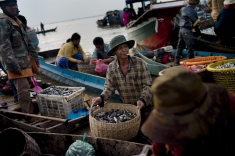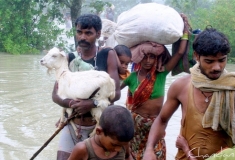Rivers and Dams Roundup for World Water Week
The theme for this year’s World Water Week is Water and Food Security, which means that many – particularly within the dam industry – will be calling for more dams to provide water storage and energy. Dams, and particularly multi-purpose dams (which are meant to provide some combination of electricity, water supply and flood control), are "back in fashion."
While dams can play an important role in supplying electricity and water, a word of caution to those getting ready to welcome this supposed new age of “clean hydropower”: the promises made by the dam industry have seldom been realized. How do we know this? Because our campaigners and civil society partners work with communities everyday that have been promised things like cheap electricity, reliable water, and improved livelihoods, but have yet to reap these rewards.
Below is an example of key issues that governments, dam practitioners and river protectors ought to consider when discussing the role of dams this week:
A healthy river means greater food security
River systems support the Earth’s highest biological diversity – and the most intense human activity. As a consequence of decades of humans exploiting rivers with large dams, water diversions and pollution, our rivers and the life they support are in a state of crisis. Large dams flood productive lands, fragment habitat, isolate species, and cut off migration routes. They reduce water and sediment flows to downstream lands, and change the nature of a river’s estuary, where many of the world’s fish species spawn. These changes are creating crises in food security for those who rely on wild foods and river-supported food crops and animals. Healthy rivers are the planet’s lifelines. To give just one example of many, the Mekong River is home to the world’s largest inland fisheries, supplying approximately 20% of the world’s freshwater fish and up to 80% of the region’s source of animal protein.
Multipurpose dams at cross-purposes
One type of dam that is enjoying a comeback is the large multi-purpose dam. At the sixth World Water Forum in March this year, the final declaration called for governments to make commitments in the water sector that would harmonize water, energy and food developments by investing in large multi-purpose dams. Yet operating a dam for its energy production is often at cross-purposes with its role as flood control or water supply. In addition, according to the World Commission on Dams, these dams have repeatedly failed to produce their supposed benefits. For instance, in order to be most effective, a flood control dam should be maintained at low water levels to make room for the incoming flood. Conversely, the efficient and economic operation of hydropower dams requires that water levels be maintained at high levels to maximize hydropower production. If operators fail to take into account all the opposing needs as well as hydrological forecasts, even the largest dams can be at risk of failure. The examples are many, especially from India and Pakistan (in 2005, flood waters after torrential rains overflowed five dams in Pakistan, killing at least 80 people, injuring many more and leaving 4,000 families homeless). More recently, the Three Gorges Dam has come under fire for its potential role in exacerbating downstream drought and water shortage conditions.
The “Green Economy” spin
Rio+20 has come and gone, with no clear agreements on how to reduce our impact on critical ecosystem services or how much to cut our carbon emissions. The one thing that governments, banks, and corporations seem to agree on, however, is that large hydropower dams can help usher in a “green economy.” Yet large dams are maladaptations for the following key reasons: (a) large dams are at huge risk from climate change's impacts on river flows; (b) healthy rivers are key to successful climate adaptation, especially for the world's poorest, who are also at greatest risk of climate change; and (c) large reservoirs can be significant sources of greenhouse gases.
Investing in real solutions to climate change
Many hundreds of large dams are being proposed or built in areas where climate change could bring great hydrological uncertainty, including the Amazon, the Mekong, Africa, China, and the Himalayas. These dams are being built based on past records of river flow, which can no longer be considered reliable. As major rivers worldwide experience dramatic changes in flow due to these dams, their natural ability to adjust to and absorb disturbances will decrease. Rather than investing in large dams – which have brought about a crash in freshwater species, huge social costs, and reductions in river flows for users and ecosystems downstream – governments should invest in truly renewable and sustainable approaches, such as decentralized community water and energy systems, in order to meet the water and energy needs of the poorest, while maintaining the health of one of our most valuable resources.
- Know of a teacher interested in exploring these issues in the classroom? Download the Climate Change, Rivers and Dams Toolkit.
- Is your home a climate change and dam building hotspot? Add your region in the map below by posting a comment to this blog:
View Global Warming and River Hotspots in a larger map
- For more on the water/energy nexus, visit Choke Point: China and Choke Point: US
- World Water Week, Stockholm, 26 - 31 Aug 2012




